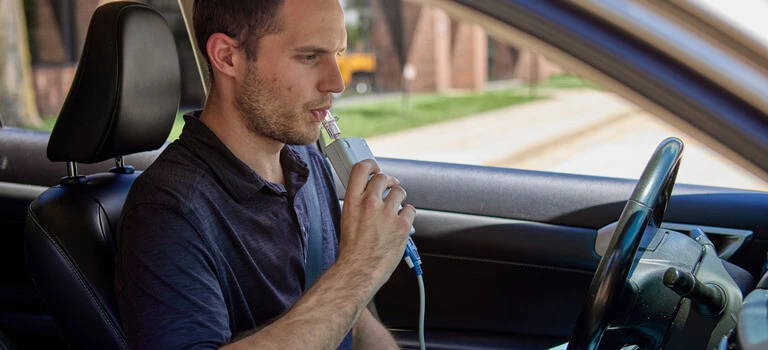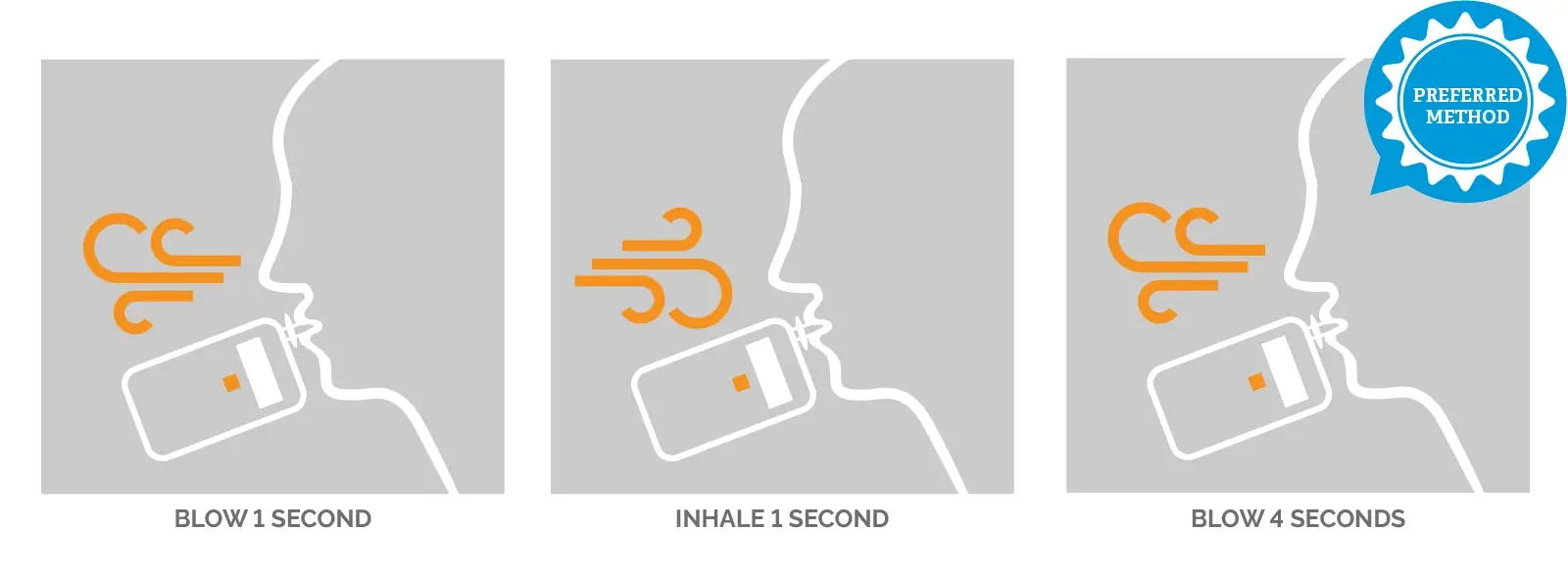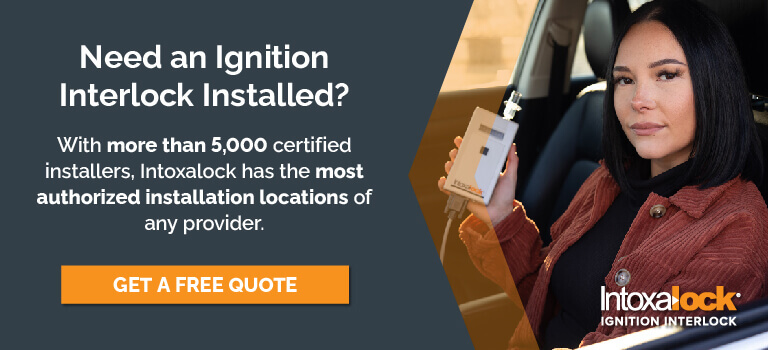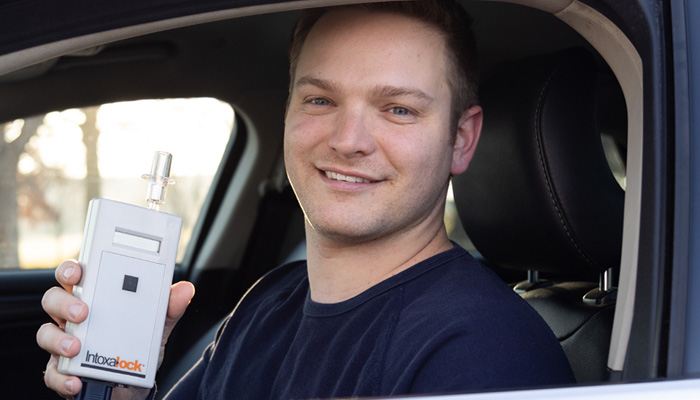Ignition Interlock Blow Patterns Explained: A Guide to Mastering Your IID

When using an ignition interlock device (IID), mastering the blow pattern, or breath pattern, is key to ensuring your vehicle starts every time. Ignition interlock blow patterns not only help the device calibrate for precise results but also prevent users from attempting to tamper with the test by using artificial breath or other means. This is why your IID device requires more than a straight-blow breath pattern, which is only blowing out.
While the basic function of all IIDs is the same, there are different ignition interlock breath patterns that you may encounter, depending on the device you choose. Understanding these blow patterns can help you decide which ignition interlock device is best for you and help you avoid unnecessary lockouts.
In this guide, we’ll explore the pros and cons of various ignition interlock breath patterns, tips for mastering the blow-inhale-blow breath pattern, and explain what to do if you have trouble blowing into an interlock device.
Blow-Inhale-Blow Breath Pattern
The blow-inhale-blow breath pattern is simple and the most effective technique for providing a breath sample to an ignition interlock device. This sequence is done in one smooth motion without any pauses and without removing your mouth from the device:
- Blow into the mouthpiece for one to two seconds
- Inhale for one to two seconds,
- Blow again until the device vibrates (about 4 seconds).

Pros of Blow-Inhale-Blow Ignition Interlock Breath Pattern
- Ease of Use: The blow-inhale-blow breath pattern is straightforward and generally easier to perform than other ignition interlock blow patterns.
- Accuracy: This breath pattern helps the device accurately measure your Breath Alcohol Concentration (BrAC) without requiring excessive force.
- Acceptance: Most states certify IID devices that use this method due to its reliability.
- Intuitive: The blow-inhale-blow breath pattern is more like natural breathing. It feels more intuitive and accessible than blowing out and/or humming out loud for 5-10+ seconds.
Cons of Blow-Inhale-Blow
- Learning Curve: While it’s easier than other patterns, it still requires some practice.
How Long Should I Blow into an Ignition Interlock Device?
The required duration of the final blow of the blow-inhale-blow pattern depends on the strength of your breath. The harder you blow, the shorter the required time.
When using the blow-inhale-blow breath pattern, you’ll usually blow for one second, inhale for one second, and then blow again until the device vibrates—typically around four seconds.
TIP: If you've had trouble blowing into an interlock device using blow-inhale-blow in the past, it might be due to spending too much time on each step. Focus on maintaining a steady pace, and practice in a calm environment to enhance consistency and avoid errors.
Blow and Hum Breath Pattern
Some IID providers require you to perform some combination of blowing into their device and/or humming, recommending that you slowly speak a particular word into the device over many seconds. This is referred to as a blow and hum breath pattern. The exact technique is hard to master, and many customers face unnecessary lockouts because of the difficult hum requirement.
While this breath pattern can be hard to master, Intoxalock IIDs can accommodate the blow and hum breath pattern where allowed, as well as the preferable blow-inhale-blow pattern.
Pros of Blow and Hum Breath Pattern
- Tamper Prevention: The combination of blowing and humming makes it difficult to bypass the device.
Cons of Blow and Hum Blow Pattern
- Complexity: The coordination required for this pattern is high, leading to a higher chance of lockouts.
- Frustration: Some users report struggling with the hum component, which can cause stress and delays.
- Awkward: Users may feel self-conscious humming into a device in front of passengers.
Choosing the Right Ignition Interlock Blow Pattern for Your Needs
When selecting an IID provider, it is important to select the ignition interlock blow pattern that you find most manageable and can perform comfortably and consistently. Intoxalock’s blow-inhale-blow pattern is generally recommended for its ease of use and reliability. Depending on your state, you may have other options, if you prefer. This could include the blow-hum-blow pattern.
If you've struggled with other breath patterns and had trouble blowing into an interlock device for extended periods, Intoxalock’s breath pattern might be the best option for you. Intoxalock IIDs also allow for alternative blow patterns, where allowed by state regulations, providing users with added flexibility.
8 Tips to Master Your Ignition Interlock Blow Pattern
1. Maintain a Steady Breath
Regardless of the ignition interlock blow pattern you’re using, maintaining a steady breath is crucial. Practice breathing evenly and consistently to avoid errors during the breath test.
2. Concentrate Your Airflow
When blowing into the device, tighten your lips firmly around the mouthpiece and avoid puffing out your cheeks. This helps direct the airflow more efficiently.
3. Ensure a Secure Seal
Place your lips snugly around the mouthpiece, ensuring no air escapes from the sides. A tight seal ensures you provide the correct airflow for accurate readings.
4. Avoid Taking the Test Right After Eating or Drinking
Eating or drinking before your test can affect your results. Avoid consuming anything at least 15 minutes before using your device and rinse your mouth out with water beforehand if possible.
5. Monitor Device Prompts Closely
Pay attention to your device’s prompts. These will guide you through the process and help you correct any errors before they result in a lockout.
6. Practice in a Calm Environment
Be sure to practice successfully passing a breath test several times. It’s best to do so before leaving your installation appointment. Ideally, you should successfully start your car at least five times consecutively without retries.
7. Understand State Laws and Requirements for IID Breath Patterns
Different states have different requirements for IID breath patterns. Make sure you understand the laws in your state and choose a device that meets those standards.
8. Clean the Mouthpiece Regularly
A clean mouthpiece ensures accurate readings and a smoother testing process. Make it a habit to clean or replace your device’s mouthpiece regularly. You can get more mouthpieces at your local Intoxalock service location.
What Happens if I Can't Pass my Ignition Interlock Breath Test?
If you fail to pass your ignition interlock breath test, your vehicle will not start, and the device may register a violation. Repeated failures can result in extended time with the IID or other penalties depending on your state laws.
What Happens If I Blow Too Hard or Too Softly into the Device?
Blowing too hard or too softly can result in an error, and you may need to retake the test. Consistency is key, so practice maintaining a steady breath. Your device’s display may prompt you to adjust for a retest, so pay attention to the display as needed.
Comparing Device Interfaces and Features
Ignition interlock devices vary not only in blow patterns but also in their interface designs. Some devices feature a simple, one-button interface that makes the testing process quick and easy, while others have more complex systems with keypads and customizable screens.
While more complex options might sound appealing, they often complicate the process without adding any significant benefit. Devices with a single button are generally the easiest to use, especially for random retests while driving.
Why Intoxalock is the Simplest Ignition Interlock
Intoxalock is designed with user-friendliness in mind. Our IID devices are typically set to use the blow-inhale-blow breath pattern, recognized for its accuracy and ease of use. Additionally, the simple one-button interface on our devices reduces the chance of error, making Intoxalock the easiest and most reliable option on the market.
Choose Intoxalock for the easiest and most reliable ignition interlock blow pattern. Contact our State Specialists at 888-283-5899 to get started today!




